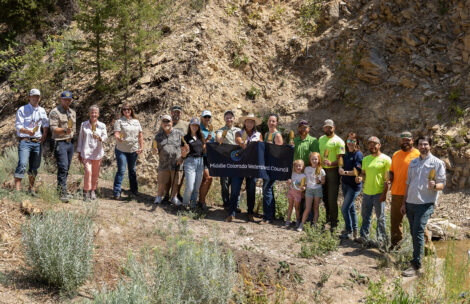Roan Creek fish barrier project groundbreaking
A milestone for native fish conservation and water infrastructure
MIDDLE COLORADO WATERSHED COUNCIL PRESS RELEASE
August 6, 2025
The Middle Colorado Watershed Council (MCWC), in partnership with Garfield County and state and federal funders, broke ground on the Roan Creek Fish Barrier Project on Tuesday, August 5. This long-anticipated conservation infrastructure project has been five years in the making and aligns directly with MCWC’s Integrated Water Management Plan (IWMP), a framework that dovetails with the larger Colorado Water Plan.
Located in a remote stretch of Roan Creek in western Garfield County, the project will construct a permanent fish barrier to protect one of Colorado’s most unique native fish assemblages—including a rare genetic strain of Colorado River cutthroat trout, as well as bluehead sucker, Paiute sculpin and speckled dace. These species are increasingly rare across the Colorado River Basin, with cutthroat trout occupying just one percent of their historic range.
The project is primarily funded through the Bureau of Reclamation’s WaterSMART Program, under the Infrastructure Investment and Jobs Act (IIJA). Additional support comes from the Colorado Water Conservation Board (CWCB), Colorado Parks and Wildlife (CPW) , the Colorado River District’s Community Funding Partnership and the Trout and Salmon Foundation. In total, the project represents a $1,034,995 investment in watershed health and habitat.
“This is a win-win for both water users and native fish,” said Garfield County Commissioner Perry Will, who served more than 40 years with CPW, including as a state wildlife officer and supervisor. “Garfield County is proud to support this project as a Category A partner, helping leverage the funding and collaboration it took to get here. The cutthroat trout in Roan Creek represent an incredibly unique genetic lineage—adapted to survive even in 80-degree waters. Keeping nonnative species like brook and rainbow trout out of this system is essential to preserving that rare genetic makeup and ensuring these fish continue to thrive.”
The project will also replace outdated irrigation infrastructure, eliminate push-up dams and install a modern concrete diversion with a headgate, fish screen and flow-measuring device —improving efficiency for water users while benefiting stream function and aquatic habitat.
Early funding from the Bureau of Land Management (BLM) supported the 90-percent design phase, completed in 2021 by Wright Water Engineers with guidance from BLM liaison and fisheries biologist Thomas Fresques.
“The construction of the fish passage barrier on Roan Creek marks a major step toward protecting and sustaining its unique native fishery,” said Assistant Area Wildlife Manager Albert Romero. “For more than 15 years, CPW and partners—including the BLM, local landowners and many others—have worked extensively throughout the drainage to conserve this vital resource.”
The Roan Creek Fish Barrier is the result of strong collaboration across local, state and federal partners. Garfield County played a key role as the Category A partner for Bureau of Reclamation funding, helping to secure vital federal support. The Middle Colorado Watershed Council continues to lead grant administration and stakeholder coordination. Wright Water Engineers serves in the project management role, and Kissner General Contractors, Inc. is constructing the structure.
“The Roan Creek Fish Barrier project is a great example of how targeted, local investments and partnerships can complete projects that support multiple benefits,” said Melissa Wills, Community Funding Partnership Program Manager at the Colorado River District. “Upgrading this infrastructure brings lasting benefits to both native ecosystems and the agricultural community. Through our Accelerator Grant Program, the River District is proud to have helped secure significant state and federal funding and to be part of the collaborative effort that made this project possible.”


